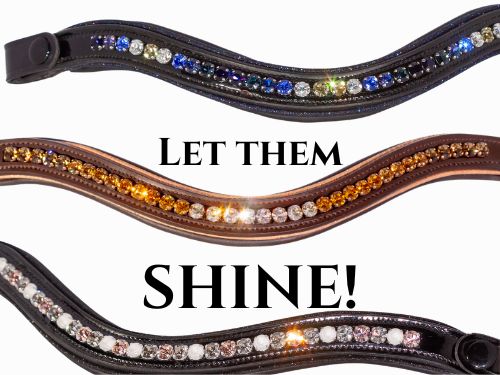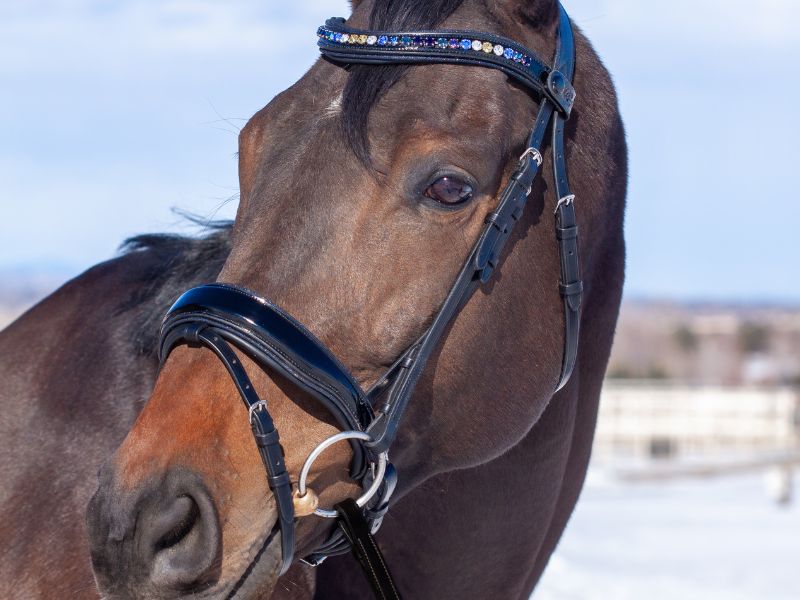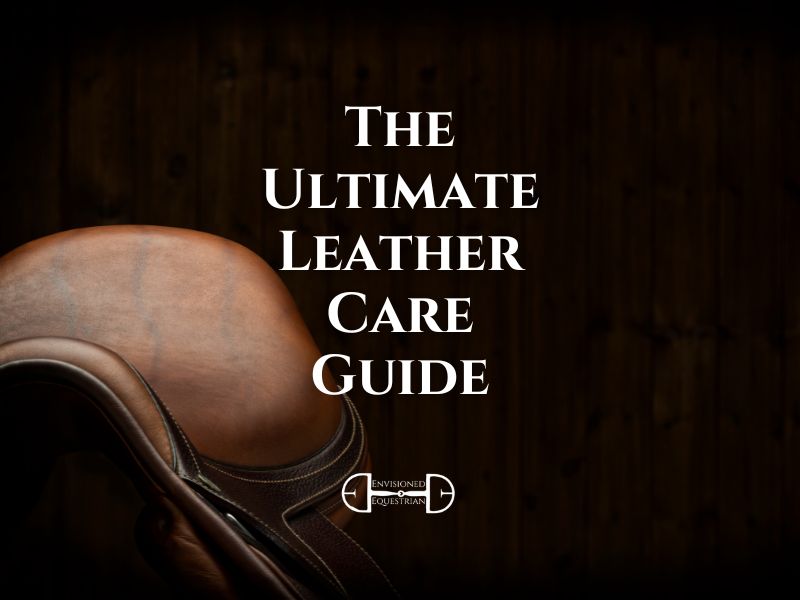
by LaceyKnight | Feb 12, 2025 | Browband, Leather goods, Tack care
A rhinestone browband is more than just an accessory—it’s a statement. Whether you love bold, flashy designs or elegant, subtle sparkle, a well-maintained browband enhances your horse’s look and ensures your tack stays in top shape. But let’s be real—dust, sweat, and everyday riding can dull that shine. So, how do you keep your rhinestone browband looking brand new? Here’s everything you need to know!
1. Regular Cleaning: Wipe Away the Dust and Grime
Your rhinestone browband picks up dust, sweat, and barn dirt faster than you think. To prevent buildup:
- After each ride, use a soft, dry cloth to wipe away any surface dust.
- For deeper cleaning, dampen a microfiber cloth with water or a mild leather cleaner and gently wipe the leather and rhinestones.
- Avoid soaking the browband—excess moisture can loosen stones over time.
2. Use the Right Cleaning Products
Not all cleaners are created equal! To preserve both the leather and the sparkle:
- Use a gentle leather cleaner for the browband itself—harsh chemicals can dry out or discolor leather.
- For rhinestones, a tiny drop of mild dish soap diluted in water works wonders. Apply with a soft toothbrush or cotton swab to get into the crevices without scratching the stones.
- Never use alcohol-based cleaners or abrasive pads—these can damage the shine and loosen the settings.
3. Store It Properly
Proper storage prevents unnecessary wear and tear:
- Keep your rhinestone browband in a soft cloth bag or padded bridle rack when not in use.
- Avoid tossing it into a tack trunk where it can rub against other gear and get scratched.
- Store in a cool, dry place—excess humidity can weaken glue settings, while extreme heat can cause leather to crack.
4. Handle with Care
Rhinestones add undeniable glamour, but they’re delicate!
- Avoid dropping or bending your browband, as this can loosen or dislodge stones.
- Be mindful when adjusting your bridle to avoid tugging on the rhinestones or pressing them against hard surfaces.
- If you notice a loose stone, secure it with a tiny dab of jewelry glue, or take it to a professional for repair.
5. Give It a Professional Refresh
Even with the best care, rhinestones can lose some of their brilliance over time. If your browband needs a little extra TLC:
- Take it to a leather specialist for professional cleaning and conditioning.
- If stones become dull or missing, consider a custom replacement or upgrade to keep your browband looking as dazzling as the day you got it.
Final Thoughts
Your rhinestone browband is meant to shine—so keeping it clean and well-maintained ensures it stays the centerpiece of your horse’s bridle. With these easy care tips, you’ll keep your browband sparkling ride after ride!
How do you keep your tack looking its best? Share your favorite care tips!
In the mood for some sparkle? View our rhinestone browbands here.

by LaceyKnight | Jan 14, 2025 | Bridle & Halter Fitting, Leather goods, Tack care
When it comes to equestrian equipment like rhinestone bridles and crystal halters, achieving the perfect fit is essential for both your horse’s comfort and performance. At Envisioned Equestrian, we believe that every piece—from brand-new luxury tack to your soft-as-butter ancient favorite—should not only look stunning but also fit seamlessly. Here’s a comprehensive guide to ensure your bridles and halters fit just right, keeping your horse happy and looking their best.
Why Proper Fitting Matters
An ill-fitting bridle or halter can cause discomfort, rubs, and even behavioral issues in your horse. A correctly fitted piece enhances communication and performance while showcasing your horse’s natural elegance. Whether you’re using a functional everyday halter or an exquisite rhinestone bridle, the right fit is non-negotiable.
Bridle Fitting Basics
1. Measuring for a Bridle
Start by measuring your horse’s head to determine the appropriate size. Most luxury bridles, including those at Envisioned Equestrian, are available in Cob, Horse, and Warmblood sizes. For custom measurements, focus on the:
- Browband: Should sit comfortably across the forehead without pinching behind the ears. A rhinestone browband, like our Winter’s Wake or Phoenix designs, adds sparkle while enhancing fit.
- Crownpiece: Should rest behind the ears without pressing on sensitive areas. Ergonomic designs are ideal for distributing pressure evenly.
- Cheekpieces: Adjust so the bit rests gently against the corners of the mouth, creating a soft wrinkle. Avoid over-tightening, as this can cause tension.
- Throatlatch: Leave enough space for four fingers between the strap and the horse’s jaw to ensure breathing is unrestricted.
2. Finding the Right Bit Position
The bit should sit evenly in the horse’s mouth, with no excessive movement. Check for proper bit fit by ensuring about 1/2 inch of space on either side of the mouth. Many horses have tongues that vary in thickness and cheeks that do so as well. When you fit a bit, you want to make sure you take these two things into consideration as well. If you like chunky bits, take a peek inside your horse’s mouth first to see how much room they have in there. Getting a big rubber bit may seem like a kind thing to do, but if they don’t have enough room in their mouth, it’s just as detrimental as getting a harsh bit that is uncomfortable for them.
3. Adjusting Nosebands
Nosebands should be snug but not tight. You should be able to fit two fingers underneath the band. This prevents discomfort and allows the horse to move its jaw naturally. Luxury bridles often feature padded or contoured nosebands for additional comfort. At Envisioned Equestrian, our nosebands take a few days to soften and bend to fit the horse’s face. Once it’s softened, you’ll have more room for adjustments.
Spotlight on Rhinestone Bridles
Rhinestone horse bridles are more than just functional; they’re a statement. Envisioned Equestrian’s collection features dazzling designs like the Twilight Tranquility or Sugar Plum browbands, perfect for adding a touch of glamour. When fitting rhinestone bridles, ensure the added embellishments don’t interfere with the horse’s movement or comfort. A well-fitted rhinestone bridle should frame your horse’s face beautifully while staying secure during work or play.
A properly fitted halter is crucial for daily handling and groundwork. Envisioned Equestrian’s crystal halters, such as the Glacial Waters Rhinestone Halter, combine elegance and practicality. Here’s how to ensure a perfect fit:
1. Adjusting the Crownpiece
The crownpiece should sit comfortably behind the horse’s ears. Opt for padded options to reduce pressure and enhance your horse’s comfort, especially during prolonged wear.
2. Finding the Right Noseband Fit
The noseband should rest about two fingers below the horse’s cheekbone. It should be snug enough to prevent slipping but loose enough to avoid pinching. Crystal horse halters with ergonomic designs offer a blend of fit and fashion, ensuring your horse stays comfortable while looking stunning.
3. Checking the Throatlatch
Ensure you can fit three fingers between the throatlatch and the horse’s jaw on a halter. This allows freedom of movement without compromising security.
Signs of a Poor Fitting Bridle or Halter
Whether it’s a bridle or a halter, look out for these red flags:
- Rub Marks or Hair Loss: Indicates excessive pressure or friction.
- Behavioral Issues: Head tossing, resistance, or discomfort during use may signal an improper fit.
- Uneven Wear: Check for imbalances, particularly in the bit or straps.
Addressing these issues promptly can prevent long-term discomfort or injury.
The Envisioned Equestrian Difference
At Envisioned Equestrian, we’re dedicated to creating rhinestone bridles and crystal halters that blend luxury and functionality. All our pieces are crafted with attention to detail, ensuring they’re as comfortable as they are stylish. Our custom sizing options mean every horse—from ponies to warmbloods—can enjoy the perfect fit.
Final Tips for Bridle Fitting Success
- Regular Checks: Horses’ shapes change over time. Reassess the fit of your bridles and halters periodically.
- Keep It Clean: Dirt and sweat can cause irritation. Clean your luxury bridles and crystal halters regularly to maintain both their beauty and functionality. Need help caring for your Envisioned Equestrian Leather? Go here.
- Seek Professional Help: If you’re unsure about the fit, consult a professional fitter or your trusted tack supplier.
When your horse’s equipment fits perfectly, they’re more comfortable, confident, and ready to shine—whether in the show ring or during daily rides. Explore Envisioned Equestrian’s stunning collection of rhinestone horse bridles and crystal halters to combine impeccable fit with unparalleled style.

by LaceyKnight | Dec 29, 2024 | Leather goods, Tack care
Your Envisioned Equestrian tack is more than just functional equipment—it’s a blend of craftsmanship, style, and utility. From luxurious leather to sparkling rhinestones, each piece deserves care to maintain its beauty and longevity. Follow this comprehensive guide to keep your tack looking as stunning as the day you brought it home.
1. Cleaning Real Leather Components
Leather is the heart of equestrian tack, prized for its durability and timeless appeal.
- Daily Care: After each ride, wipe down the leather with a damp, soft cloth to remove sweat and dirt.
- Deep Cleaning: Use a quality leather cleaner once a month. Apply with a sponge or cloth, gently working it into the surface.
- Conditioning: Restore the leather’s natural oils with a conditioner. Avoid over-conditioning, as it can soften the leather excessively.
- A brand we love: Effax. Give it a try. You won’t be disappointed!
Pro Tip: Keep leather out of direct sunlight and away from moisture to prevent cracking or mold growth.
2. Maintaining Vinyl and Fabric Elements
The vinyl fabrics and other materials add versatility and flair to your tack.
- Use a damp cloth and mild soap to clean these components. Avoid harsh cleaners that might strip colors or weaken the fabric.
- Let the tack air dry completely before storing.
- For fabrics, spot-clean with a gentle fabric cleaner and allow to dry thoroughly.
3. Preserving Rhinestones in Settings
Rhinestones are the sparkling highlight of your tack, so keeping them brilliant is essential.
- Dust rhinestones with a soft, dry toothbrush or microfiber cloth to remove debris.
- If needed, gently clean with a damp cloth—avoid soaking the rhinestones, as water can weaken the settings.
- Store tack in a cool, dry place to protect the stones from discoloration or loosening.
Pro Tip: Avoid exposing rhinestones to abrasive cleaners or oils, which can dull their shine.
4. Storing Your Tack Properly
Storage is as important as cleaning when it comes to prolonging the life of your tack.
- Use padded bridle bags or tack hooks in a well-ventilated tack room.
- Keep items away from direct heat or sunlight to preserve colors and materials.
- Check periodically for signs of wear and address any issues promptly to prevent further damage.
5. Regular Inspections and Repairs
Tack takes a lot of wear and tear, so regular inspections are key.
Look for:
- Loose rhinestones or rhinestone settings.
- Cracks in leather or stitching.
- Tears or frays in fabric elements.
When in doubt, consult a professional for repairs.
More Resources for Equestrian Care
- Explore our Bridle Collection for replacement pieces or new designs.
- Browse our Browbands for sparkling updates to your current setup.
Proper care of your Envisioned Equestrian tack ensures it stays as elegant and functional as ever. With routine cleaning, mindful storage, and timely repairs, your tack will serve you beautifully for years to come.
Looking for more equestrian tips and products? Visit our Blog for expert advice and inspiration, or shop the Full Collection to find your next favorite piece.



